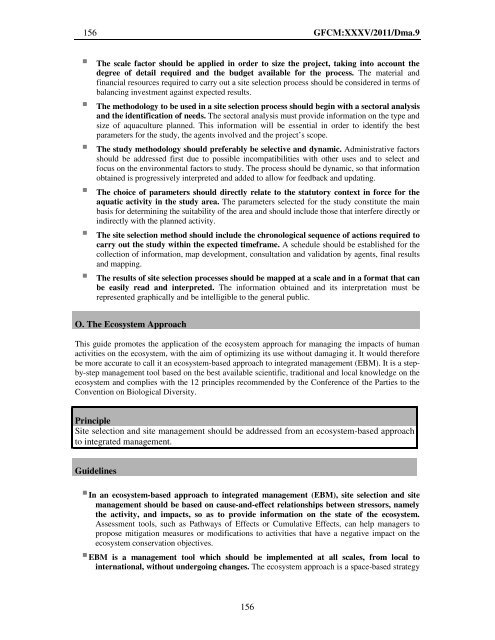Site selection and carrying capacity in Mediterranean ... - FAO Sipam
Site selection and carrying capacity in Mediterranean ... - FAO Sipam
Site selection and carrying capacity in Mediterranean ... - FAO Sipam
You also want an ePaper? Increase the reach of your titles
YUMPU automatically turns print PDFs into web optimized ePapers that Google loves.
156 GFCM:XXXV/2011/Dma.9<br />
The scale factor should be applied <strong>in</strong> order to size the project, tak<strong>in</strong>g <strong>in</strong>to account the<br />
degree of detail required <strong>and</strong> the budget available for the process. The material <strong>and</strong><br />
f<strong>in</strong>ancial resources required to carry out a site <strong>selection</strong> process should be considered <strong>in</strong> terms of<br />
balanc<strong>in</strong>g <strong>in</strong>vestment aga<strong>in</strong>st expected results.<br />
The methodology to be used <strong>in</strong> a site <strong>selection</strong> process should beg<strong>in</strong> with a sectoral analysis<br />
<strong>and</strong> the identification of needs. The sectoral analysis must provide <strong>in</strong>formation on the type <strong>and</strong><br />
size of aquaculture planned. This <strong>in</strong>formation will be essential <strong>in</strong> order to identify the best<br />
parameters for the study, the agents <strong>in</strong>volved <strong>and</strong> the project’s scope.<br />
The study methodology should preferably be selective <strong>and</strong> dynamic. Adm<strong>in</strong>istrative factors<br />
should be addressed first due to possible <strong>in</strong>compatibilities with other uses <strong>and</strong> to select <strong>and</strong><br />
focus on the environmental factors to study. The process should be dynamic, so that <strong>in</strong>formation<br />
obta<strong>in</strong>ed is progressively <strong>in</strong>terpreted <strong>and</strong> added to allow for feedback <strong>and</strong> updat<strong>in</strong>g.<br />
The choice of parameters should directly relate to the statutory context <strong>in</strong> force for the<br />
aquatic activity <strong>in</strong> the study area. The parameters selected for the study constitute the ma<strong>in</strong><br />
basis for determ<strong>in</strong><strong>in</strong>g the suitability of the area <strong>and</strong> should <strong>in</strong>clude those that <strong>in</strong>terfere directly or<br />
<strong>in</strong>directly with the planned activity.<br />
The site <strong>selection</strong> method should <strong>in</strong>clude the chronological sequence of actions required to<br />
carry out the study with<strong>in</strong> the expected timeframe. A schedule should be established for the<br />
collection of <strong>in</strong>formation, map development, consultation <strong>and</strong> validation by agents, f<strong>in</strong>al results<br />
<strong>and</strong> mapp<strong>in</strong>g.<br />
The results of site <strong>selection</strong> processes should be mapped at a scale <strong>and</strong> <strong>in</strong> a format that can<br />
be easily read <strong>and</strong> <strong>in</strong>terpreted. The <strong>in</strong>formation obta<strong>in</strong>ed <strong>and</strong> its <strong>in</strong>terpretation must be<br />
represented graphically <strong>and</strong> be <strong>in</strong>telligible to the general public.<br />
O. The Ecosystem Approach<br />
This guide promotes the application of the ecosystem approach for manag<strong>in</strong>g the impacts of human<br />
activities on the ecosystem, with the aim of optimiz<strong>in</strong>g its use without damag<strong>in</strong>g it. It would therefore<br />
be more accurate to call it an ecosystem-based approach to <strong>in</strong>tegrated management (EBM). It is a stepby-step<br />
management tool based on the best available scientific, traditional <strong>and</strong> local knowledge on the<br />
ecosystem <strong>and</strong> complies with the 12 pr<strong>in</strong>ciples recommended by the Conference of the Parties to the<br />
Convention on Biological Diversity.<br />
Pr<strong>in</strong>ciple<br />
<strong>Site</strong> <strong>selection</strong> <strong>and</strong> site management should be addressed from an ecosystem-based approach<br />
to <strong>in</strong>tegrated management.<br />
Guidel<strong>in</strong>es<br />
In an ecosystem-based approach to <strong>in</strong>tegrated management (EBM), site <strong>selection</strong> <strong>and</strong> site<br />
management should be based on cause-<strong>and</strong>-effect relationships between stressors, namely<br />
the activity, <strong>and</strong> impacts, so as to provide <strong>in</strong>formation on the state of the ecosystem.<br />
Assessment tools, such as Pathways of Effects or Cumulative Effects, can help managers to<br />
propose mitigation measures or modifications to activities that have a negative impact on the<br />
ecosystem conservation objectives.<br />
EBM is a management tool which should be implemented at all scales, from local to<br />
<strong>in</strong>ternational, without undergo<strong>in</strong>g changes. The ecosystem approach is a space-based strategy<br />
156
















